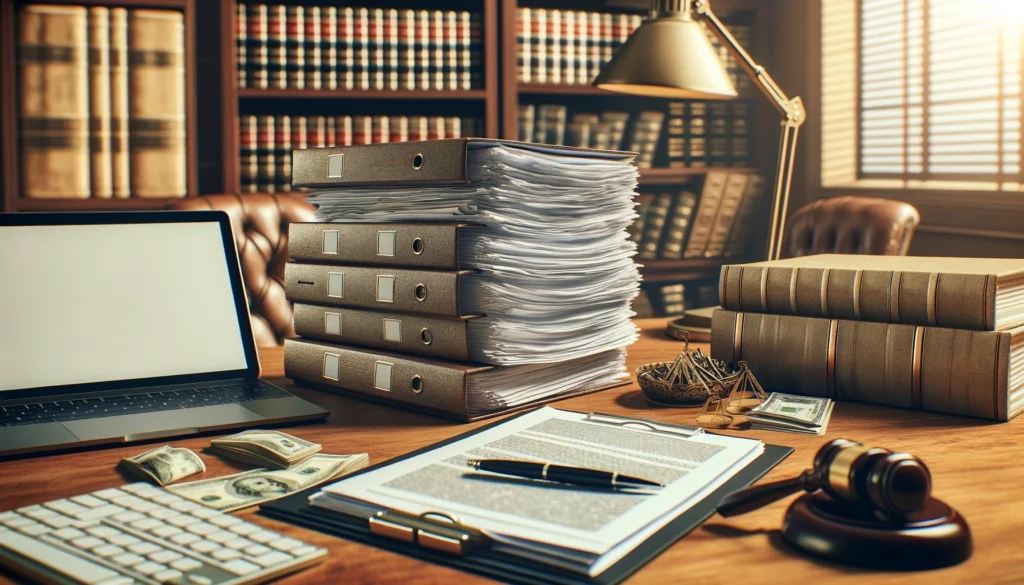
A New Era for Paralegals: Embracing AI for Efficiency
In the demanding world of personal injury law, paralegals often find themselves submerged in an ocean of paperwork and tight deadlines. Among these tasks, preparing personal injury settlement brochures can be particularly time-consuming. The traditional manual methods used often lead to delays and inefficiencies.
However, the advent of artificial intelligence, especially tools like ChatGPT, has brought about a significant transformation. By leveraging AI, paralegals can streamline the preparation of these brochures, making the process faster and more efficient. Embracing this technology doesn’t just ease the workload; it enhances the overall quality of the end product.
As we delve into how ChatGPT can revolutionize these tasks, let’s first understand how to set it up effectively for legal work.
Laying the Foundation: Basic ChatGPT Knowledge and Setup
Getting started with ChatGPT for legal work is simple yet requires careful planning. Begin by creating an account with an AI service provider like OpenAI. Once registered, familiarize yourself with the platform’s interface and functionalities.
For paralegals, it is crucial to use AI responsibly. Always ensure that the information fed into ChatGPT is accurate and relevant to the case. Confidentiality and ethical considerations should be paramount. Double-check for any biases or inaccuracies that the AI might introduce.
When equipped with the right knowledge and setup, ChatGPT can be a powerful tool in a paralegal’s arsenal. The next step is to master the art of crafting the perfect prompt.
Crafting the Perfect Prompt: The Art of Precision and Detail
To extract the best outputs from ChatGPT, paralegals need to create precise and detailed prompts. This precision ensures that the AI understands the exact requirements and delivers relevant answers.
Here are some tips for creating effective prompts:
- Be Specific: Clearly state what you need. For example, instead of asking “What is a settlement brochure?” ask “Provide an introduction for a personal injury settlement brochure considering a car accident scenario.”
- Context Matters: Provide background context to guide the AI. For instance, “Summarize the medical history of Jane Doe who was involved in a vehicular accident resulting in a fractured leg.”
- Break Down: Divide complex requests into simpler steps. For example, instead of a general request, use a sequence of prompts to gather information on liability, damages, and settlement offers.
By refining these prompts, paralegals can harness ChatGPT efficiently for various sections of a settlement brochure. Let’s explore the step-by-step approach next.
Also read:
Building Your Brochure: From Introduction to Conclusion with ChatGPT
Creating a comprehensive and compelling settlement brochure using ChatGPT involves a structured approach. Here’s a step-by-step guide:
- Introduction: Start with a prompt like, “Draft an introduction for a personal injury settlement brochure focusing on a slip and fall case in a commercial property.” This sets the stage for your entire document.
- Case Summary: Use specific prompts to generate detailed case summaries. For example, “Summarize the incident involving Ms. Smith, who slipped on an unmarked wet floor in XYZ Mall, leading to severe back injury.”
- Medical Reports: Generate medical narratives by prompting, “Describe the medical treatments received by Mr. Doe after the car accident that resulted in a broken arm and concussion.”
- Liability Section: For exploring liability, prompt, “Explain the liability aspects in a case where a pedestrian is hit by a delivery truck while crossing an intersection.”
- Damages and Compensation: Detail the losses and compensation sought with, “List the economic and non-economic damages for a claimant in a wrongful death case involving a workplace accident.”
- Conclusion: Wrap up with a strong conclusion by prompting, “Draft a concluding statement emphasizing the need for a fair settlement considering the ongoing medical expenses and pain endured by the victim.”
By following these steps, paralegals can ensure that each section of the brochure is cohesive and impactful. Now, let’s look at how ChatGPT assists in gathering nuanced information efficiently.
Also read:
Nuanced Information Gathering: Leveraging AI for Research Efficiency
ChatGPT can significantly accelerate the research phase by quickly gathering background information and case histories. Here are some practical tips:
- Quick Queries: Use prompts like, “Summarize the key points of the landmark personal injury case XYZ vs. ABC.”
- Data Validation: Always cross-reference AI-generated data. Prompt ChatGPT to double-check facts, such as, “Verify the plaintiff’s claims and cross-reference with court documents.”
- Comprehensive Overviews: Prompt for overviews of relevant laws by asking, “Outline the main provisions of the state’s personal injury statutes.”
While ChatGPT can streamline information gathering, the reliability of AI-sourced data remains crucial. Let’s move forward to enhancing the persuasive elements of your brochure with ChatGPT.
Also read:
Enhancing Persuasive Elements: Utilizing LLMs for Compelling Narratives
Creating compelling and empathetic narratives is essential for personal injury settlement brochures. ChatGPT can help craft these with emotional precision and factual accuracy.
Here’s how:
- Victim Impact Statements: Prompt, “Draft a victim impact statement for a mother who lost her child in a DUI incident, highlighting the emotional and psychological toll.”
- Persuasive Arguments: Use prompts focused on empathy and evidence, such as, “Write a persuasive argument for why the defendant should settle due to the plaintiff’s enduring pain and inability to return to work.”
- Balanced Narrative: Ensure the narrative is balanced by asking, “Combine factual precision and empathy to describe the financial and emotional hardships faced by the victim’s family.”
By fine-tuning these elements, paralegals can create brochures that resonate deeply with the audience. However, human oversight remains an indispensable part of the process.
Also read:
Review and Revision: Human Oversight in the AI Collaboration
Despite the efficiency of AI, the accuracy and legal compliance of the content must be reviewed by a human. Here’s why:
- Accuracy Check: Ensure all facts and figures are accurate and match the case details.
- Legal Compliance: Verify that the AI-generated content adheres to legal standards and practices.
- Editing: Edit for clarity, coherence, and tone to ensure the final document meets professional standards.
Human oversight ensures that the brochure not only leverages AI’s capabilities but also maintains the highest standards of quality. Now let’s explore how AI can help with visual elements.
Beyond Text: Visuals and Appendices Assistance from AI
Beyond textual content, ChatGPT can aid in generating ideas for visual elements and appendices that complement the brochure. Here’s how:
- Visual Ideas: Prompt, “Suggest visual elements like charts and images that can enhance understanding of the injury and recovery timeline.”
- Appendix Content: Ask, “Generate a comprehensive list of appendices, including medical bills, expert testimonies, and accident scene photographs.”
By incorporating these elements, paralegals can create more engaging and informative brochures. Next, let’s consider future advancements in legal AI tools.
Also read:
Future Considerations: Evolving with Legal AI Tools
As AI continues to evolve, keeping abreast with the latest tools and technologies will be crucial. Paralegals must:
- Stay Updated: Regularly update on new AI advancements and tools.
- Continuous Learning: Engage in ongoing learning and training to utilize AI tools effectively.
- Adaptation: Be ready to adapt to new methods that can further streamline tasks.
This proactive approach will ensure paralegals remain at the forefront of technological advancements.
Also read:
Final Thoughts: Empowering Paralegals Through Innovation
The transformative potential of AI, particularly ChatGPT, in streamlining paralegal tasks is immense. By embracing these innovative tools, paralegals can enhance their efficiency and output quality, ultimately contributing to better client outcomes and streamlined legal processes.
“`


